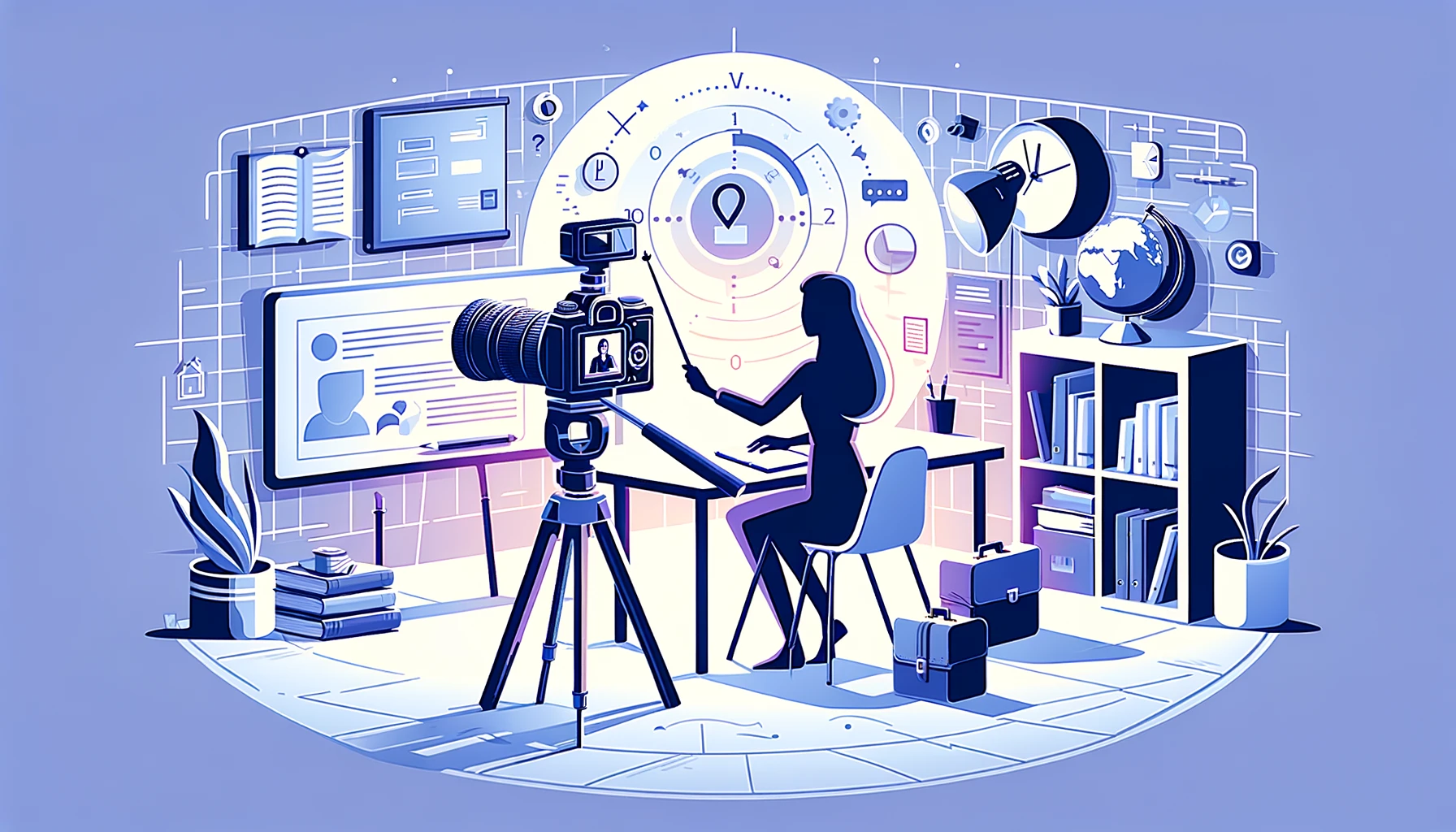
Create AI videos with 230+ avatars in 140+ languages.
Create AI videos with 230+ avatars in 140+ languages
The secret to great video content lies not just in the subject you choose or the camera you use. If you want to make truly good videos, master the art of lighting.
As American film director Aaron Rose said, "In the right light, at the right time, everything is extraordinary."
Understanding the nuances of the best lighting for video and how to use it to create mood and enhance clarity will improve the quality of your production.
Does lighting improve video quality?
Good lighting is crucial in enhancing your video quality. Along with making people and objects stand out from the background, light can also change your video's aesthetic and mood. While the sun is one of the best (and most affordable) lights for video, studio lights are a great way to create hundreds of eye-catching effects and atmospheres, even when inside.
The best lighting for video quality gives your shot a more naturalistic look and guides the viewer's emotions, invoking feelings like sadness, happiness, mystery, or excitement.
In contrast, poor video lighting pulls viewers out of your story, making them focus on the flaws rather than the content. A dimly lit scene loses details in the darkness, whereas a too-bright scene casts harsh, dark shadows and creates unflattering and unnatural-looking footage. Both too much and too little light will leave your video looking artificial and staged.
This video demonstrates the profound impact of good lighting and how different setups can transform a scene's visual appeal. Even though it's aimed at YouTube video creators specifically, it covers the fundamentals of a professional setup and is a great starting point if you don't know much about lighting:
Which lighting is best for making videos?
Choosing the best lighting for video recording depends on the effect you intend to produce and your shooting environment. The most recommended setup is the three-point lighting system, consisting of a key light, fill light and backlight. Alternatively, you can try two-light and four-light setups, loop lighting, and ring lights, which offer flexibility for different styles and moods.

If you look closely, you'll see all three types of light in this video interview setup.
The best lighting for video recording is the one that helps you:
- Set the video's tone, whether professional, casual, or dramatic.
- Ensure that the props don't look flat because of poor background light.
- Make the presenter look natural, highlighting their facial expressions and body language and maintaining the viewer's focus on them.
Why you should use soft and diffused lighting sources
Soft lighting wraps around the subject and reduces contrast, offering a more natural and appealing appearance. You can achieve light diffusion in an indoor space by matching your light source with professional softboxes or using some DIY solutions (white fabrics or paper).
Overcast weather naturally provides this diffused soft light when filming outdoors, enveloping the subject in a gentle, even glow ideal for a video shoot. In contrast, the light coming directly from the sun tends to be harsh and directional. Harsh lighting creates strong shadows and high contrast that you must counteract. You can use reflectors that bounce the overhead lighting or additional light sources to balance the harshness and soften the overall lighting of your scene.
How appropriate color temperature can make or break your video
The appearance of light, described in color tones and measured in Kelvin (K), is called color temperature. It ranges from warm (yellow/orange) to cool (blue) tones and can significantly affect the video's mood.
Typically, sunlight is considered the standard reference point, falling around 5600K. It's a cooler light compared to the orange tones of indoor lighting that range around 3200K, but this natural lighting color is preferred because of its balanced, neutral look. Adjusting the color temperature in your videos is one of the most popular video lighting tips because it helps create a specific atmosphere or mood.
With videos that focus on a human (like presenter videos, tutorials, or testimonials), neutral to slightly warm color temperatures create a welcoming and friendly atmosphere. Product demos, however, need more balanced, neutral color temperatures for a clean, professional look.
While video lighting during film production is as good as possible, editors often color grade a video in post-production, adding additional color effects like the teal and orange look. As long as your soft lighting is good, your color temperature can always be adjusted after filming.
The 4 types of lights in video production
Whether the subject of your video recording is a person or an object, there are four primary types of light you can choose from to ensure the best lighting:
- Key Light: The primary light source, usually the brightest and most influential in setting the scene.
- Fill Light: Soft light that balances the key light, reducing shadows and contrast.
- Back Light: Helps to separate the subject from the background, adding depth and dimension.
- Ring Light: Provides even, diffused light that's particularly flattering for close-up shots.

Types of video lighting
Here's a bit more detail on each type of light and when you'd want to use it.
A key light is your primary source, placed on one side of the camera. Usually, the brightest and most dominant key lights set the scene's tone and visibility, casting defining shadows and giving depth to the subject. The key light is used with various videos as long as it isn't too bright to produce harsh lighting. Still, this type of video lighting is particularly useful in interview setups or powerful scenes, where shadows and depth are essential to create dramatic effects.
A fill light is softer and less intense and sits on the opposite side of the camera from the key light. It softens or eliminates the harsh shadows the key light creates and helps balance the light across the subject. Because it prevents details from getting lost in the shadows, soft light is indispensable in corporate videos or product demonstrations, where you want to reveal details without overpowering shadows.
A backlight, also known as a rim light, sits behind the subject, creates a delicate rim of light, and helps separate them from the background. This separation can make a huge difference. It adds depth and dimension to the shot, preventing the subject from appearing flat against the background and ensuring the best lighting in portrait video recording.
A ring light is a circular light that surrounds the camera lens or the subject, provides even diffused light and is a favorite among online video creators. It minimizes shadows and highlights features, creating a professional look even in amateur setups. When planning close-up work like live demos, tutorials, webinars, or self-recorded videos, ensure you include ring lights in your video lighting equipment.
As for how you create these types of light, there are no strict rules. The key light, for instance, could be artificial — a professional LED panel or your ceiling lights — or natural lighting — coming from the sun. Similarly, fill light and backlight can be improvised using DIY reflectors made of foil or other reflective surfaces you have at hand. The exception is the ring light, which is a unique light source. Because of its specific shape, it is hard to replicate naturally.
How to choose the best lighting setup for your video production
When you create videos, you combine different types of light using specific schemes. Each video lighting scheme has unique strengths and applications, and experimentation will help you spot the right lighting for your particular project and significantly improve the quality of your videos.
Three-point lighting is your classic, go-to lighting setup. It places the key light on one side of the camera, the fill light on the opposite side, and a backlight behind the subject, all at specific angles. And you can increase the brightness and change the color of each light to emphasize emotion. Three lights ensure the best lighting because they create a balanced, professional look suitable for interviews, narratives, and more.
There are a few other options when it comes to lighting for video. Each comes with pros and cons, and will generate a different emotional look:
- A two-light setup uses just the key and fill lights but is often supplemented with a natural light source or a bounce card (a reflective surface that redirects light). You can use two lights if you aim for a more natural, less stylized look or don't have space for a full three-point lighting setup.
- A four-light setup adds another layer to the three-point video lighting — a background light that illuminates the background and enhances the context of your scene. You probably won't need this lighting setup that much, but try using four lights if you ever feel you could use extra light in the background to add even more depth to a scene.
- Loop lighting is a simpler yet effective setup involving two lights — typically, a key light and a backlight. The key light is placed at an angle to create a small shadow (or 'loop') under the nose, adding depth and dimension to the subject's face. This setup is popular for portrait or talking head videos focusing on the subject's features.
- A one-light approach, a.k.a. the beginners' favorite setup, revolves around a ring light that provides even, flattering illumination. This one is ideal for scenarios where the subject directly addresses the camera or when simplicity and speed are key. Beauty vloggers commonly use it on their YouTube videos and interviewers and online educators in different filming settings.
Instantly awesome lighting for video with AI
When you're just starting out with video creation, especially if you're on a tight schedule, achieving this look can be tricky, even if you know all the video lighting tips in the book. In that case, "digital doubles" or AI avatars can be a great workaround that spares you from using lighting equipment. These avatars are perfectly lit, regardless of the physical environment (aka the template where you use them), ensuring your videos always look professional.
You can create and customize an AI avatar using the AI video-maker Synthesia. There are 240+ avatars to choose from, and they can speak in 140+ languages. You can mix and match each avatar to choose any face, voice, and accent combo you like. You can even customize your avatar's clothing color and branding elements.
AI Avatars always have a perfect 3-point lighting setup. To see an AI avatar in action, take a look at how they're made:
7 rules to help you get the best video lighting
Great video lighting can help your presenter hypnotize the audience and take your video content from good to outstanding at lightning speed. Use the following video lighting tips and rules to produce just the right effect and create the perfect ambiance for your story.
Rule 1: Choose an environment you can control
Light can play tricks on you, so the best way to manage it and ensure great lighting is by producing videos in an environment you can control. This could mean shooting in a studio with professional studio lighting or in a quiet room where you can manipulate artificial lighting. Alternatively, an AI video maker can generate the perfect lighting for you and help you avoid the traditional lighting challenges altogether.
Rule 2: Never skip the preparation stage
A tidy environment looks better on camera and reduces unwanted shadows and reflections. Before filming, declutter, clean, and organize your set. Choose your prompts carefully, too, because these can make your video more appealing and contribute to the story you want to tell.
Rule 3: Aim for consistent color temperature
When you set up your lighting for video, check and match color temperature ratings to get a consistent Kelvin value throughout the shooting. Staying consistent with color temperature is critical for your scenes to have a coherent visual tone. Otherwise, mixed lighting with different color temperatures will produce a mismatched, unprofessional look.
Rule 4: Avoid glare on glasses
If your subject wears glasses or uses a glass cup, the reflections could reveal your studio setup or block important visual elements. To reduce the glare, position your lights at angles that don't reflect directly off the glass, such as higher than the subject or to the side. Avoiding glare without affecting the subject's comfort can also be done by slightly adjusting the positioning of the glass.
Rule 5: Use natural lighting to your advantage
Natural light is powerful and free. If you don't have studio lighting or you're shooting videos outside, early morning and late afternoon (golden hours) will provide you with soft, warm light. But if you want stronger contrasts and a more dramatic effect, schedule your shooting midday — just don't forget that the overhead lighting produced by the direct sunlight can sometimes be too powerful.
Rule 6: Experiment with angles and positions
Even the right equipment can be used wrong. Try different lighting angles and positions because experimentation is vital to finding what works best for your video. Side lighting can bring out textures, while backlighting can create an ethereal glow. Just move your light sources around, and you can drastically change the mood and feel of your scene.
Rule 7: Have at least one LED light
LED lights are a must-have in your lighting equipment. They let you adjust the intensity, and thanks to their compact size, you can reposition them easily while experimenting with different lighting setups. Plus, they're energy-efficient, generate less heat, and offer a range of color temperatures.
Ready to create AI videos with perfect lighting?
Thinking about saying goodbye to lighting equipment and hello to stunning AI-powered content?
Explore the world of hassle-free, perfectly lit videos with Synthesia and make your own videos from plain text.
Try this free AI video maker to see how you can quickly create professional videos with a flawlessly illuminated virtual presenter.
About the author
Video Editor
Kyle Odefey
Kyle Odefey is a London-based filmmaker and content producer with over seven years of professional production experience across film, TV and digital media. As a Video Editor at Synthesia, the world's leading AI video platform, his content has reached millions on TikTok, LinkedIn, and YouTube, even inspiring a Saturday Night Live sketch. Kyle has collaborated with high-profile figures including Sadiq Khan and Jamie Redknapp, and his work has been featured on CNBC, BBC, Forbes, and MIT Technology Review. With a strong background in both traditional filmmaking and AI-driven video, Kyle brings a unique perspective on how storytelling and emerging technology intersect to shape the future of content.

Frequently asked questions
How do professionals light for video?
Professionals light for video by using a systematic approach that combines multiple light sources to create depth, dimension, and visual interest. The foundation of professional lighting involves positioning lights at specific angles to control shadows, highlight the subject, and separate them from the background, while maintaining consistent color temperature throughout the scene.
Most professionals start with a key light as their primary source, then add fill lights to soften shadows and backlights to create separation. They also pay careful attention to the quality of light, often using diffusion materials like softboxes or bounce cards to create softer, more flattering illumination that wraps around the subject naturally.
What is the three-point lighting setup and when should I use it?
The three-point lighting setup is the gold standard for video production, consisting of a key light (your main source), a fill light (to balance shadows), and a backlight (to separate the subject from the background). This classic configuration creates a balanced, professional look by placing the key light on one side of the camera, the fill light on the opposite side, and the backlight behind the subject, all at specific angles.
You should use three-point lighting whenever you need a polished, professional appearance, particularly for interviews, corporate videos, testimonials, or any content where the subject needs to look their best. This setup works exceptionally well because it provides complete control over how your subject appears on camera, allowing you to adjust the mood and emphasis by changing the intensity and color of each light.
How can I achieve natural, soft lighting for videos without expensive equipment?
You can achieve natural, soft lighting by taking advantage of free or inexpensive light sources and simple diffusion techniques. Position your subject near a window during overcast days for perfectly diffused natural light, or use white sheets, paper, or even shower curtains to soften harsh sunlight coming through windows.
For artificial lighting, you can create professional results with affordable LED panels or even household lamps by bouncing the light off white walls or foam boards to create a larger, softer light source. The key is understanding that soft light comes from large light sources relative to your subject, so any technique that increases the apparent size of your light source will create more flattering, natural-looking illumination.
What color temperature should I use to keep my business videos consistent?
For business videos, maintain a consistent color temperature between 5000K and 5600K, which provides a neutral, balanced look that appears professional and natural. This daylight-balanced temperature works well for most corporate settings and ensures your videos have a clean, modern appearance that viewers associate with quality and professionalism.
Consistency is crucial across all your video content, so standardize your lighting setup and always check that all your light sources match in color temperature. Mixed lighting with different color temperatures creates an unprofessional, distracting appearance that can undermine your message, while consistent color temperature helps establish your brand's visual identity and makes your content instantly recognizable.
Can Synthesia help me create perfectly lit videos without cameras, lights, or a studio?
Yes, Synthesia eliminates all traditional lighting challenges by providing AI avatars that come with perfect three-point lighting built in, regardless of the template or background you choose. This means you can create professional videos with consistently excellent lighting without investing in equipment, learning complex techniques, or dealing with setup time.
The AI avatars in Synthesia are professionally lit during their creation process, ensuring every video you produce maintains broadcast-quality lighting standards. This approach saves significant time and resources while guaranteeing your videos always look polished and professional, allowing you to focus on your message rather than technical production details.














